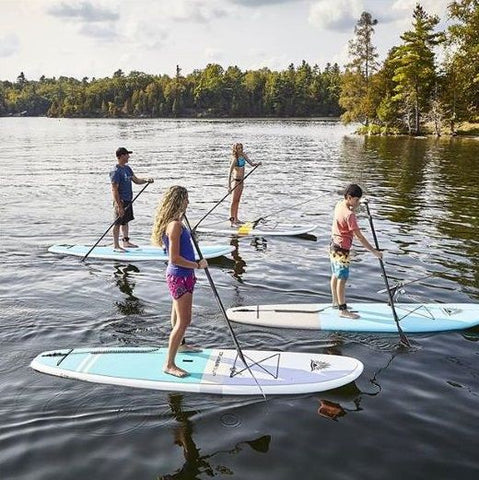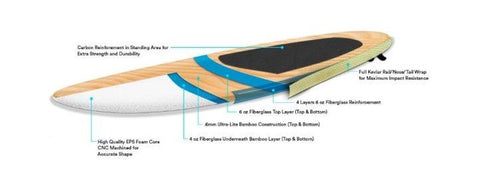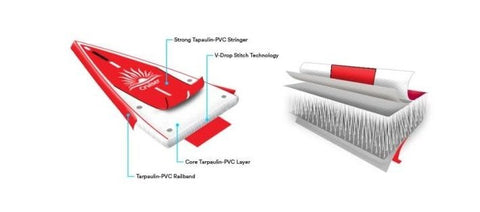When it comes to picking the type of stand up paddle board to purchase, one key choice is between an inflatable (also called iSUP’s) and a traditional hard (epoxy, fiberglass) construction.
Very often we are asked “are inflatable SUPs any good?” or "are they worth it" in comparison to a regular hard hard board. Lets take a look at the main factors of storage and transport, convenience, safety, and performance to see if inflatables are actually worth it?

What Are The Main Differences Between Hard and Inflatable Paddle Boards?
Both are paddle boards, however the huge difference is how they are made. Hard boards are just that, solid boards with an EPS foam core that is then covered (also known as laminated) with layers of fiberglass and other materials such as carbon, wood, bamboo, or other materials to make up the hard outer shell.

Inflatables on the other hand are made of two sided PVC vinyl drop stitch material, that is then glued together. They are completely hollow to allow them to be inflated with air. To inflate, you use the included hand pump and invest about 15 minutes to inflate.

Are Inflatable SUP Boards Worth It If I Have Limited Storage Space?
Hard boards take up as much space as the board is long to store. If you have an 11' board, you are going to need 11' of storage space to store your board. This is no problem if you have a garage, shed, or any other similar storage.
Inflatables come in back packs that are about the size of a large suitcase.They take up quite a bit less space than hard boards and can be stored in a closet quite easily.
The Verdict - If you have very limited storage space and can not store a hard board, then an inflatable stand up paddle board IS worth it. Spoiler alert, this is the only section where inflatables beat out hard boards, so keep reading!

Are Inflatable SUP Boards Worth It If I Want The Most Convenient Stand Up Paddle Board?
Hard boards are always ready, grab and go. If you are lucky enough to live near, or on the water, you can be on the water instantly. Just grab your paddle and go. If you have to drive to the water, just put your board on the roof rack and strap it down, and take it off when you get there.
Inflatable boards are a different story. When you get to the water, you have to inflate your board. Most do not realize how hard it is to inflate an iSUP to usable air pressure. Prepare yourself for 15 minutes of very hard, hot, and tiring pumping every time you want to go paddling. Then, after you paddle, you have to deflate it and try to get it to fit back into the carry case (easier said than done).
The Verdict - Pumping up inflatables is very hard, and time consuming, You will be tired out before you even start to paddle. Hard boards are ready to go at all times. If you value convenience and want to spend more time paddling than pumping, inflatable boards ARE NOT worth it.

Are Inflatable SUP Boards Worth It If I Want The Safest Stand Up Paddle Board To Use?
Hard boards are made of an EPS foam core covered in fiberglass and other materials. They are not filled with air, and can never lose their buoyancy. If you manage to damage your hard stand up paddle board while paddling (ie you hit a rock), you will still be able to safely paddle it back to shore to assess the damage and get it repaired.
Inflatable boards when holding air pressure are themselves safe. However, the issue of safety arises if they stop holding their air pressure while paddling. Nearly all inflatable stand up paddle boards are a single chamber design, meaning all the air is in one chamber. This is like a bicycle tire in that they are either inflated, or flat. There is very little middle ground. In the case of a major and sudden air lose, such as a failed valve or blown seam, your board will instantly lose all its air, rendering it unable to support your weight. At this point, you are on the water with a board you can not paddle, nor use to get back to shore. If you can easily swim to shore or get rescued, that is great (and lucky). However, if you are far from shore then things like exhaustion and hypothermia can really start to creep into the equation.
The Verdict - Hard boards can be damaged, however, never to the point that they can not still support your weight and be paddled. They can not deflate, they can not fill with water and sink, and can always safely get you to shore if damaged while paddling.
iSUP's that experience a loss of air pressure will leave you stranded in the water, unable to paddle your board. Imaging trying to float in a pool on an air mattress that has no air. Not fun. For the stand up paddle boarder who wants the safest board, inflatable stand up paddle boards ARE NOT worth it.

Are Inflatable SUP Boards Worth It If I Want The Best Performing Stand Up Paddle Board?
Performance can be a bit subjective. However, when we look at performance for this comparision, we looked at glide speed, stability, and tracking.
Hard boards, due to their shaping and bottom designs are able to glide in the water quicker. Due to the manufacturing process, inflatables boards have very little in the sense of bottom or rail shaping, and substantially more rocker. If I have an inflatable board and hard board of similar design, I will always be faster on the hard board due in part to the shape and design. Hard boards also sit differently in the water, where as inflatables tend to sit on top of the water, making them more prone to the effects of the wind pushing you off a straight line course.
Inflatables, being filled with air, are not as stiff as hard boards. Some boards that inflate to higher air pressures (17psi and higher) will feel reasonably stiff, but still nowhere near as stiff as a hard board. Cheap iSUP's that do not inflate to 15psi will feel like you are standing on an air mattress. They will be soft, and flex in the middle under your weight. Being softer, inflatables boards will flex more from the tip to the tail when paddling in rougher waters. Hard boards to not have this tip to tail flex. While both inflatables and hard boards have high side to side stability, the added dimension of an inflatable flexing from tip to tail makes them feel less stable, especially in rougher waters.
Finally, the polished and smooth materials, as well as rounded and sleek curves of a hard board glide quicker through the water. The higher friction material that inflatables are made of will not allow for as smooth, or fast, glide.
The Verdict - If you are looking for the best performance board on the basis of glide speed, stability, and tracking, inflatables boards ARE NOT worth it.

Are inflatable paddle boards worth it?
For our money, inflatable stand up paddle boards ARE NOT worth it when compared to hard boards. The main exception to this are if you really don't have storage space for a hard board. Other cases where an inflatable board could be something to consider is if you are a white water paddler, or if you plan to travel extensively by airline an iSUP can be checked as baggage where as hard boards are subject to oversize handling fees. However, if you are looking for the most convenient, the safest, and the best performance stand up paddle board, then inflatables paddle boards ARE NOT worth it and you should be considering a hard board.
Do agree or disagree? Did we miss something? Comment below or email us at info@cruisersup.com

